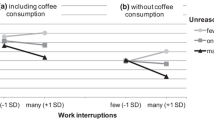Abstract
Of 1492 teachers 791 (53%) responded to a survey addressing whether voiding habits at work or behavioral factors influenced by this occupation predisposed women to urinary tract infection. The mean number of voids during the work day was 2.7±1.4; 24.5% voided infrequently (never or only once) and 26.5% voided four or more times during the work day; 15.8% had had a urinary tract infection in the preceding year. Half of the respondents made a conscious effort to drink less while working, to avoid needing to use the toilet. There was no association between the prevalence of urinary tract infection and the number of voids or infrequent voiding at work. Compared to women who drank the volume they desired at work, those who drank less had a 2.21-fold higher risk (95% CI 1.45–3.38) of urinary tract infection after controlling for being parous, voiding infrequently at work, and urge incontinence. Further study is warranted to determine whether modification of behavioral factors at work can reduce the incidence of urinary tract infections. If this association holds, public policy must be changed to allow workers more adequate access to toilet facilities.
Similar content being viewed by others
References
Nicolle LE, Ronald AR. Recurrent urinary tract infection in adult women: diagnosis and treatment.Infect Dis Clin North Am 1987;1:793–806
Hooton TM, Scholes D, Hughes JP et al. A prospective study of risk factors for symptomatic urinary tract infection in young women.N Engl J Med 1996;335:468–474
Buckley RM, McGuckin M, MacGregor RR. Urine bacterial counts after sexual intercourse.N Engl J Med 1978;298:321–324
Foxman B, Chi J-W. Health behavior and urinary tract infection in college-aged women. J Clin Epidemiol 1990;43:329–337
Hooton TM, Hillier S, Johnson C, Roberts PL, Stamm WE.Escherichia coli bacteruria and contraceptive method.JAMA 1991;265:64–9.
Fihn SD, Lathan RH, Roberts P, Running K, Stamm WE. Association between diaphragm use and urinary tract infection.JAMA 1985;254:240–245
Lapides J, Costello RT, Zierdt DK, Stone TE. Primary cause and treatment of recurrent urinary infection in women: preliminary report.J Urol 1968; 10:552–555
Lalli AF, Lapides J. The infrequent voider.Radiology 1969;92:1177–1183
Nielsen AF, Walter S. Epidemiology of infrequent voiding and associated symptoms.Scand J Urol Nephrol 1994;Suppl 157:49–53
Adatto K, Doebele KG, Galland L, Granowetter L. Behavioral factors and urinary tract infection.JAMA 1979;241:2525–2526
Foxman B, Frerichs RR. Epidemiology of urinary tract infection. II. Diet, clothing, and urination habits.Am J Public Health 1985;75:1314–1317
Remis RS, Gurwith MJ, Gurwith D, Hargrett-Bean NT, Layde PM. Risk factors for urinary tract infection.Am J Epidemiol 1987;126:685–694
Hernandez v. Nabisco. CV 153713 Ventura Cty. Supt. Ct. filed March 29, 1995
Herbert B. ‘A broken connexion’.New York Times 21 August 1995; p 14
Bendtsen AL, Andersen JR, Andersen JT. Infrequent voiders syndrome (nurses bladder).Scand J Urol Nephrol 1991;25:201–204
Lapides J. Mechanisms of urinary tract infection.Urology 1979;14:217–225
Robinson AG. Posterior pituitary. In: Bennett JC, Plum F, eds. Cecil textbook of medicine, 20th edn. Philadelphia: W.B. Saunders, 1996; p 1222
Eckford SD, Keane DP, Lamond E, Jackson SR, Abrams P. Hydration monitoring in the prevention of recurrent idiopathic infections in pre-menopausal women.Br J Urol 1995;76:90–93
Foxman B, Frerichs RR. Epidemiology of urinary tract infection; I. Diaphragm use and sexual intercourse.Am J Public Health 1985;75:1308–1312
Snyder R. Governor signs ‘potty parity’ bill into law. United Press International, 18 September 1987
Author information
Authors and Affiliations
Additional information
EDITORIAL COMMENT: The authors address an important issue which has largely been ignored, both in the literature and by public legislature.
Toilet access at work is a public health issue with far-reaching ramifications. The majority of women in the workforce have free access to toilets; however, recent reports suggest that certain companies have instituted employment practices that encourage urine retention. This may actively encourage women to consciously decrease their fluid intake at work and may lead to subsequent health problems, including urinary tract infections.
This is a descriptive study conducted by survey of female public school teachers in two midwestern school districts. The survey included questions regarding voiding habits at work, allotted breaks, bladder complaints and subsequent urinary tract infections.
Unfortunately, this type of study is difficult to employ. Drawbacks include the lack of questions regarding sexual activity, which has been strongly linked to subsequent urinary tract infections. Also, the response rate was fairly low, at 53%. The authors acknowledge these drawbacks and also comment on the fact that documentation of the urinary tract infections was not assessed objectively. Even though these drawbacks are significant and affect the study to a large degree, important questions are raised regarding public policy towards toilet access at work. This study is important in that it increases our awareness of this problem and the significant impact it may have on womens’ lives and health issues. This will, hopefully, stimulate further research to determine whether limited access to toilets at work influences the incidence of urinary tract infections and other urinary complaints in women.
Rights and permissions
About this article
Cite this article
Nygaard, I., Linder, M. Thirst at work — an occupational hazard?. Int Urogynecol J 8, 340–343 (1997). https://doi.org/10.1007/BF02765593
Issue Date:
DOI: https://doi.org/10.1007/BF02765593




